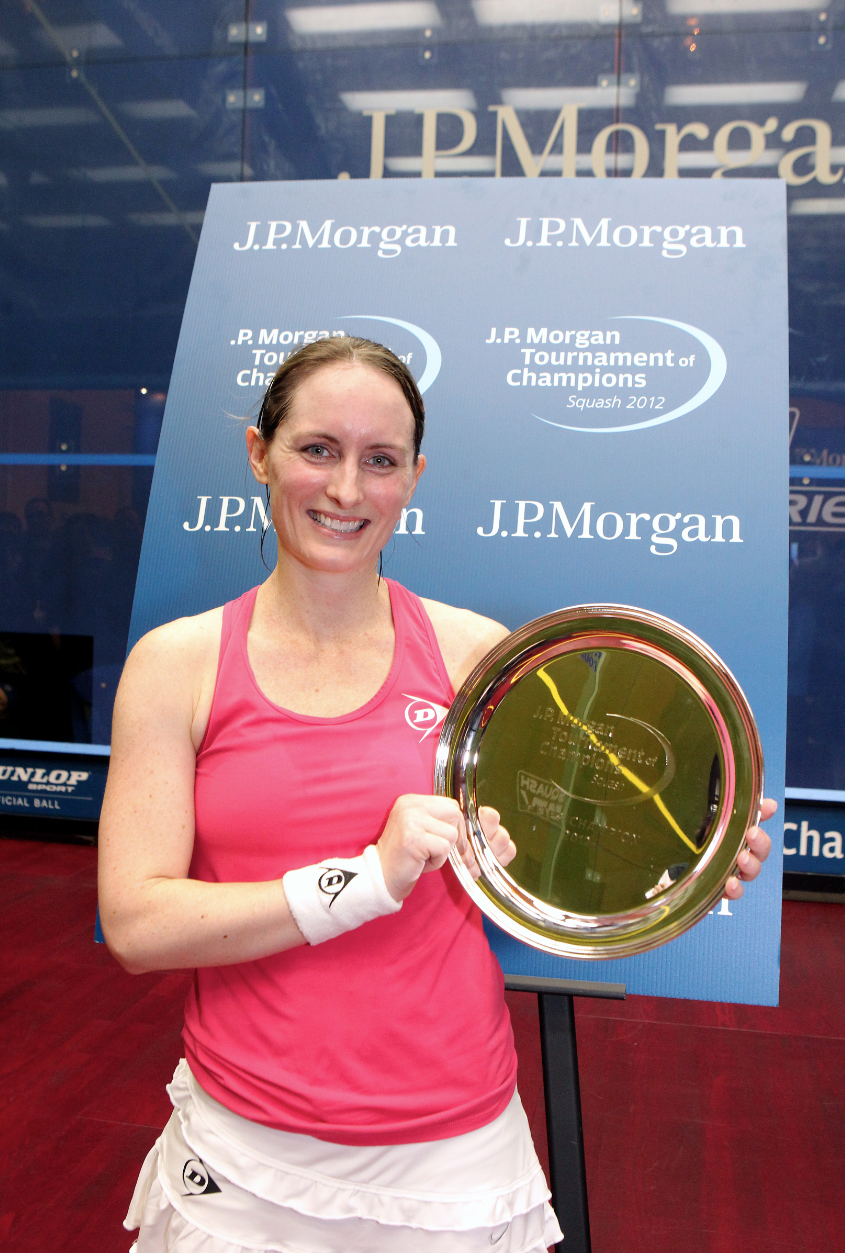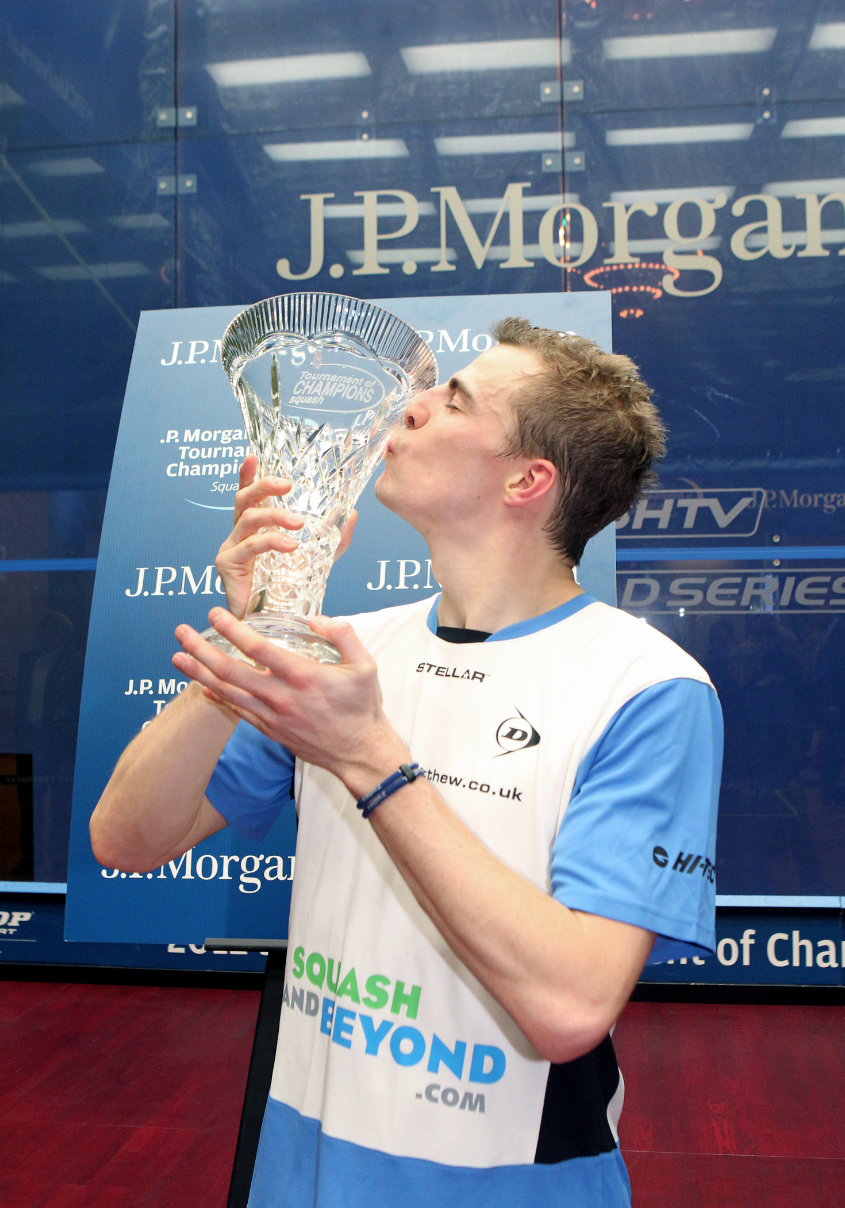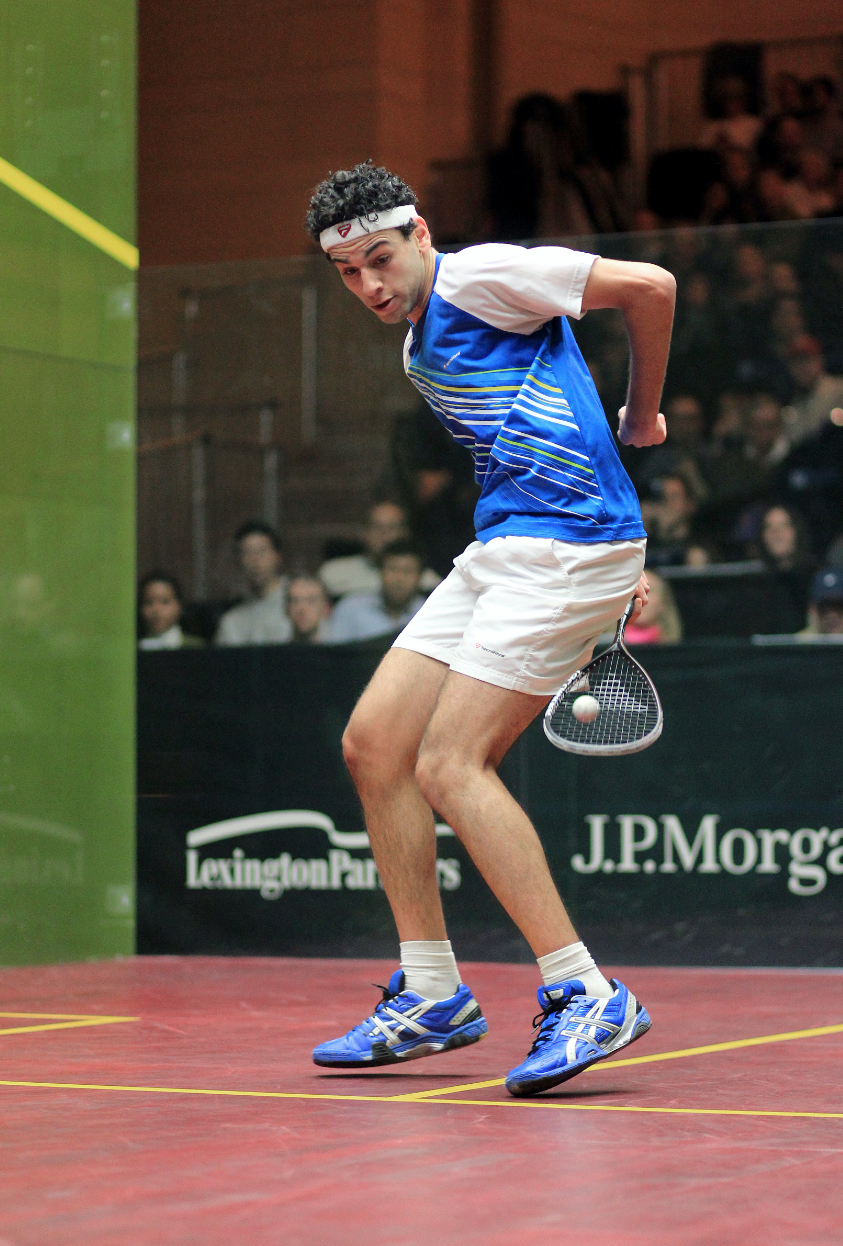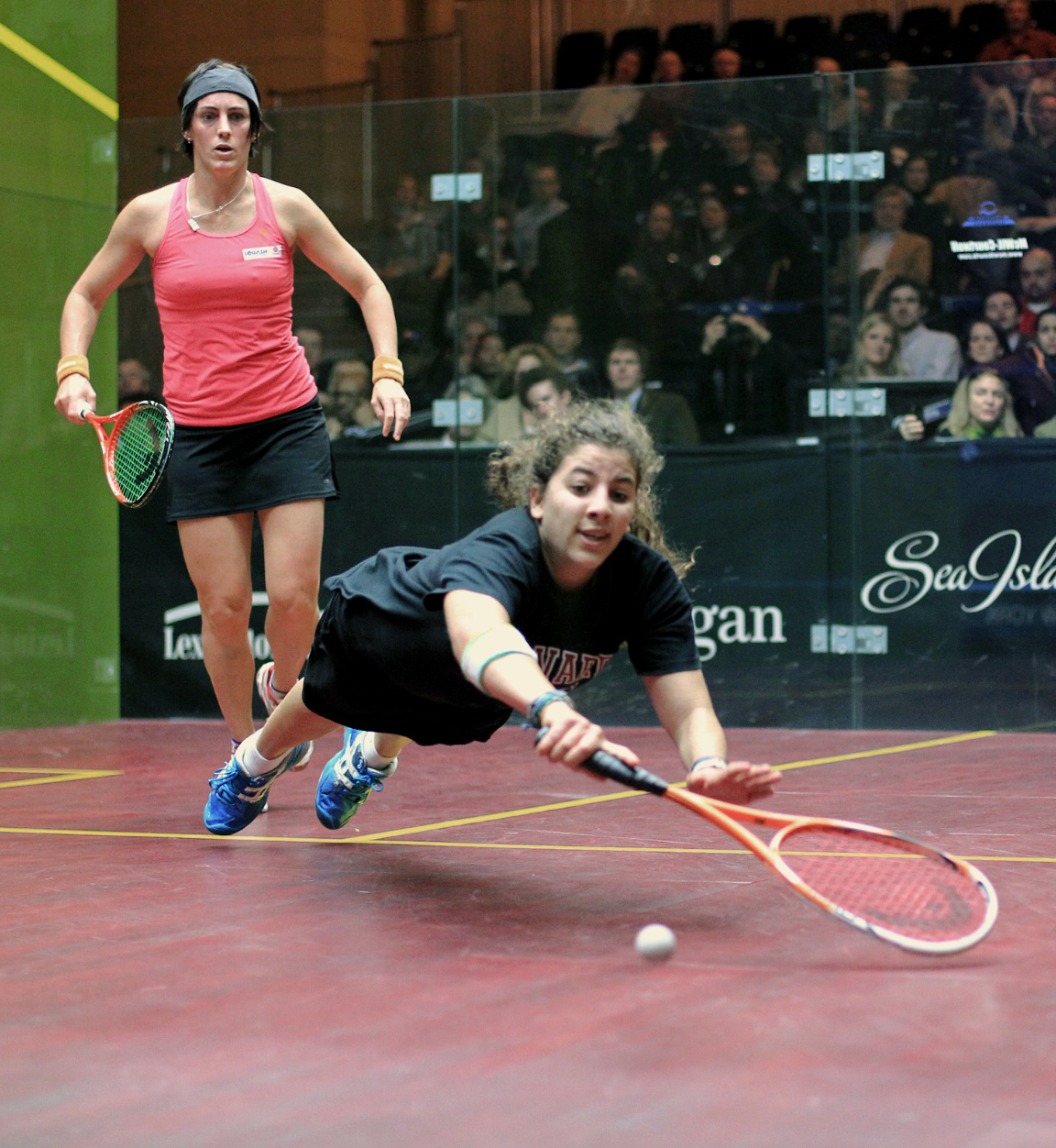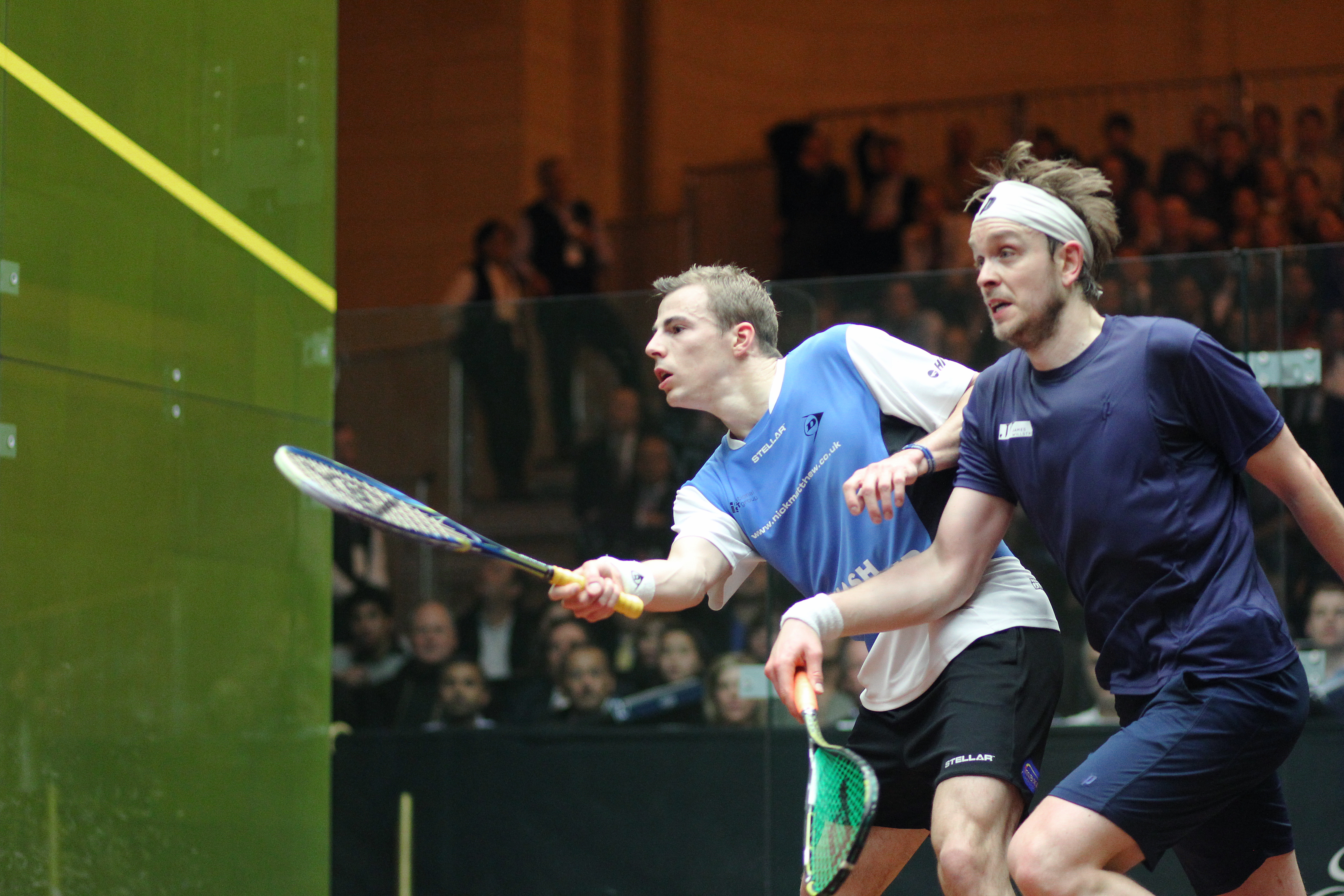
By James Zug
Photos by Steve Line/SquashPics.com
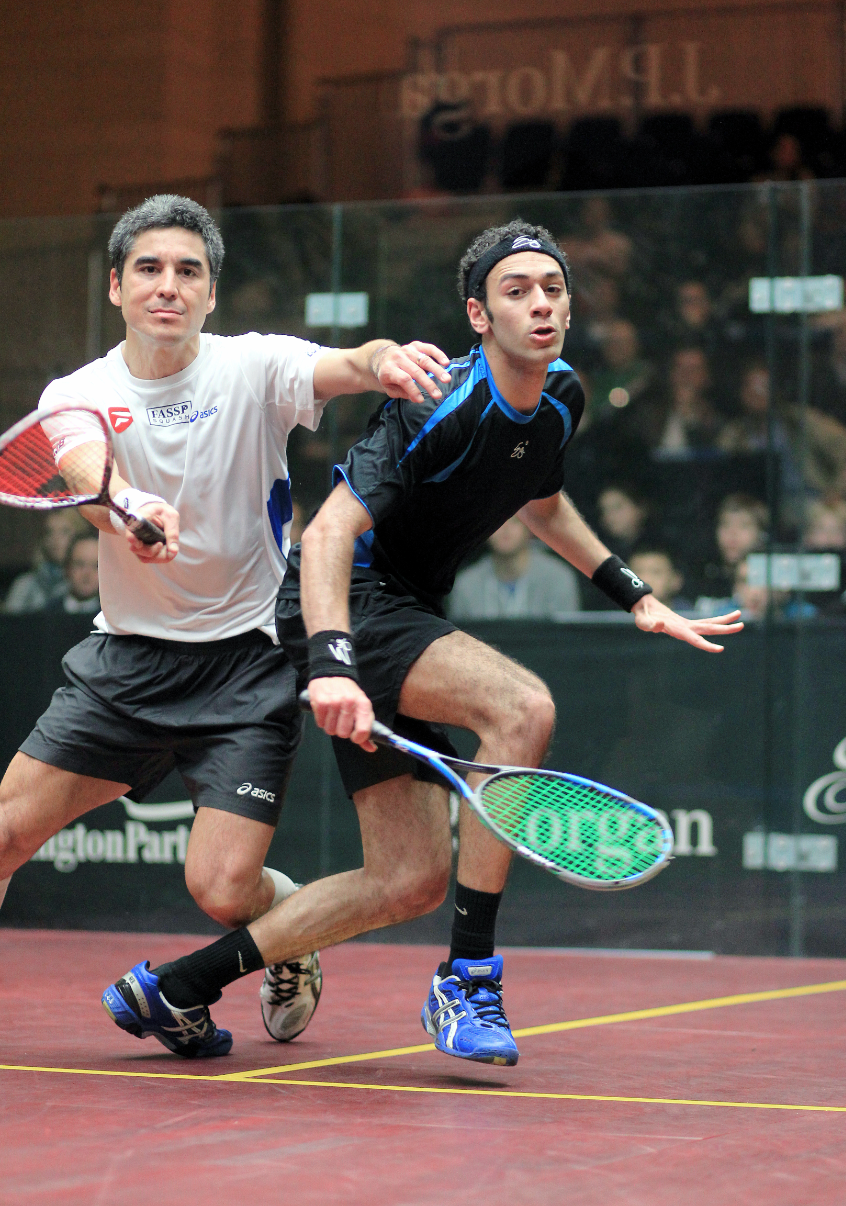
There was something primal about it: two Yorkshiremen battling it out in a glass box at a city train station a continent away from home, surrounded by hundreds of screaming people, gladiators in a modern age. In addition, a subterranean fissure was evident. The one Yorkshireman couldn’t beat the other.
One of the enduring streaks on the pro tour has been Nick Matthew beating James Willstrop. Before the finals of the 2012 J.P. Morgan Tournament of Champions, Matthew had won their past 11 PSA matches, including the tense, two-hour final of the 2009 British Open which he clinched 12-10 in the fifth after being down 2-1. Willstrop hadn’t beaten Matthew since December 2007 at the English Open in Matthew’s home town of Sheffield.
You see this sort of blockage at all levels. In fact, the day of the ToC finals was the same day that Rafael Nadal beat Roger Federer in the Australian Open and that afternoon I asked both James Willstrop and Nick Matthew about it, about the fact that Rafa just seems to have Roger’s number. You know the stat, that Roger hasn’t beaten Rafa in a Grand Slam since 2007. They both demurred, saying their rivalry was different.
The four-year streak looked like it might end in New York. Willstrop had been on a tear of late, winning his last three tournaments of 2011 (Hong Kong, Kuwait and India) and vaulting to the number one position in the world rankings for the first time. On the first day of the ToC, I stood next to him courtside and must have heard more than a dozen fellow players come up and congratulate him on that achievement.
At the same time, Matthew was in hibernation. After repeating as world champion in November in Rotterdam, he crashed out of Hong Kong in the quarters and then withdrew before his quarterfinal match in Kuwait with an adductor injury. He went home to England and rested and watched as his neighbor knocked him off the top of the world rankings. “It was a tough couple of months,” Matthew said after the finals. “It was frustrating to lose the No. 1 spot while I was inactive. I was pretty low and not much fun to be around.”
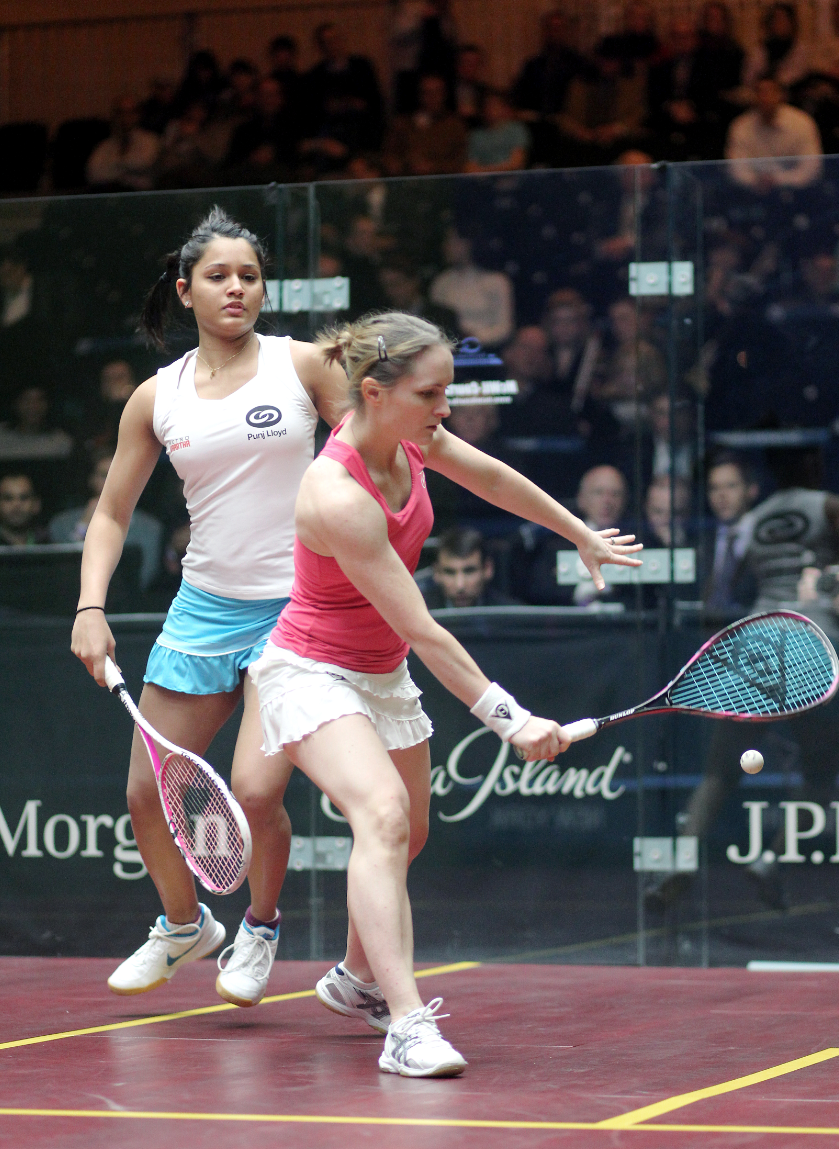
The final, then, was shaping to be a beaut: the new World No. 1 against the old No. 1, the top two seeds, two men who grew up together and the burning question: can Willstrop break through? Adding spice was the fact that Matthew pretty much had captured every major title in squash except for the ToC—he had previously lost three times in the final. Did he have a curious Grand Central curse?
It was a testy, scrappy match from the start. Five minutes passed and amidst a flurry of territory-staking lets, the score was still 1-1. The new video review system played a key role in the first game. Willstrop, down 7-5, asked for a review on a stroke given to Matthew. It was overturned and Willstrop reeled off the next five points and nine of the next ten. Twice he wrong-footed Matthew in crucial sequences. In the second game, Willstrop tinned four times and allowed leads of 8-6 and 9-7 slip away. “That was a key moment,” Willstrop said after the match. “That was when I should have put it away.”
Up 5-4 in the third, Matthew fist pumped after a winner. For him, it was the moment when he established himself in the match, when he knew he had Willstrop pinned down again. The game went short—the other three games all lasted more than twenty minutes but this was just eleven—and you could see Willstrop’s confidence flagging. He was playing his new style, being more patient, attacking only when he had created an opening. But against the super aggressive Matthew, he got worn down. In the fourth, he faulted on his serve: he was lob-serving, quite effectively at that, but for many it was the first time they had seen a professional fault on the serve. (The only other time anyone could remember was the semis of the British Grand Prix in Manchester in September 2010 when at 9-all in the fifth Greg Gaultier had inexplicably served below the cut line; his opponent was Willstrop.) Matthew went on to the last two games comfortably at 11-5 and 11-7.
“To be perfectly honest, I did my best,” Willstrop said after the match. “I accept it and I’ll move on. I keep trying to learn and improve and not worry about it. It will happen soon.”
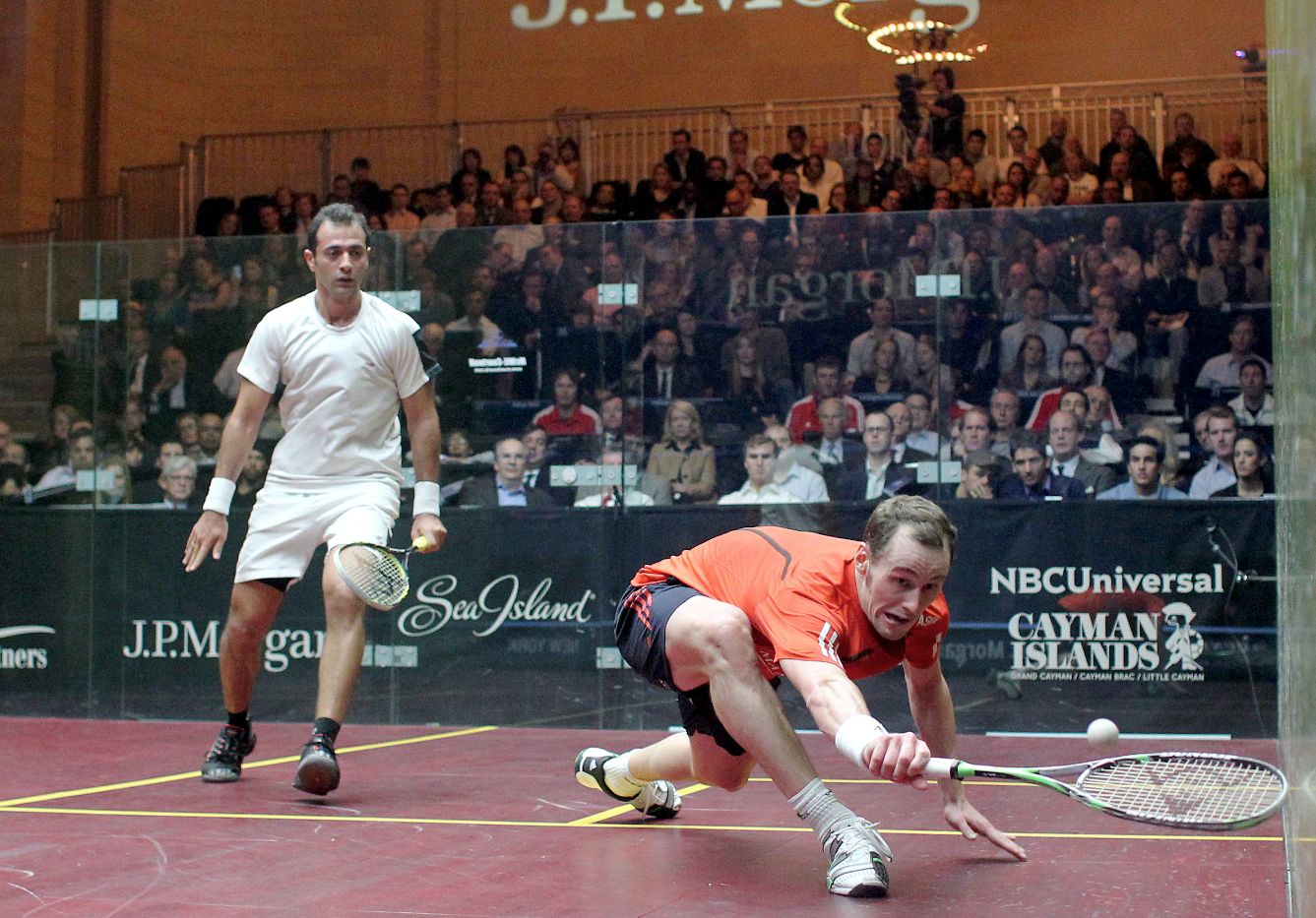
The drama at the end was a fitting conclusion to the 15th ToC in Grand Central. The first Tournament of Champions came in June 1995. “A Racket at Rush Hour,” trumpeted Sports Illustrated in an article written by Harvard champion Jordanna Fraiberg. (In it, Fraiberg noted that Mark Talbott was the highest-ranked American at the time, 81 in the world, and he wasn’t even playing regularly on the softball tour.)
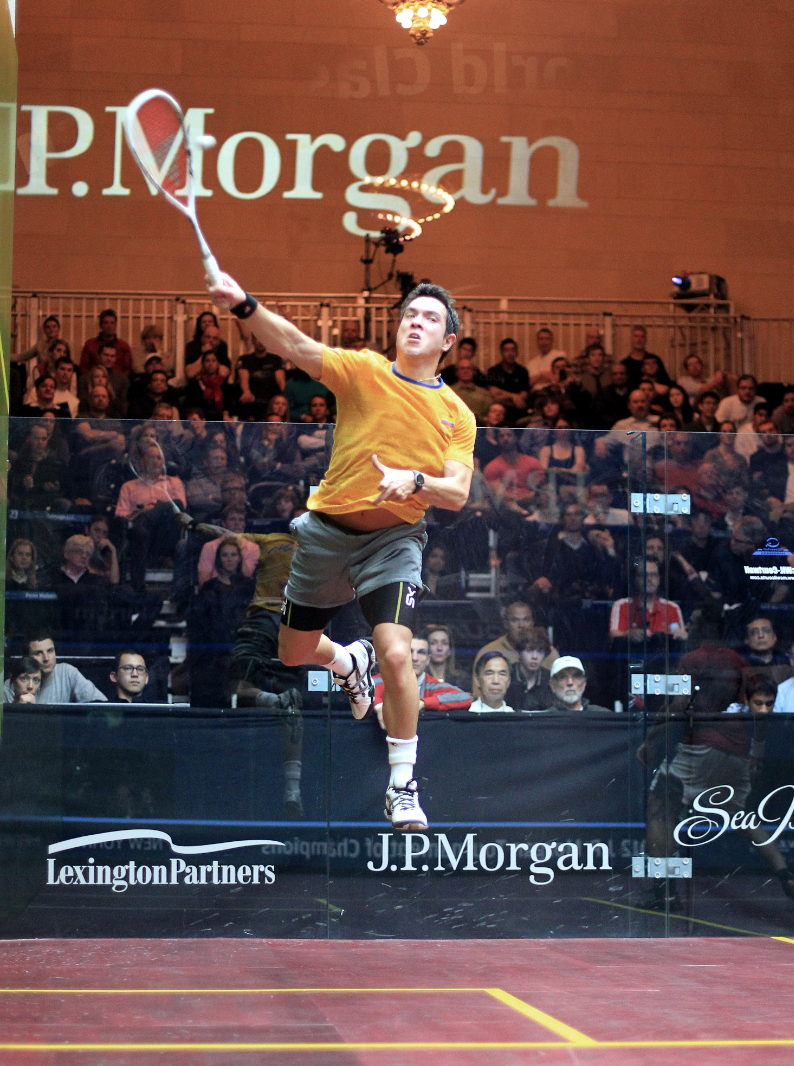 After a nearly four-year hiatus, the ToC resumed in the winter of 1999 and has run annually ever since. “When does an effort become an institution?” John Nimick asked in the tournament program. Having reached its crystal anniversary, the ToC is now a bedrock of the American squash scene, the players’ favorite tournament and a perfect window in the game. In 1995 Fraiberg estimated that 20,000 people passed the court each day; today the estimate is much more than that—perhaps 750,000 people go through Grand Central each day. This has enabled Nimick to brand the ToC as the world’s largest squash spectator event.
After a nearly four-year hiatus, the ToC resumed in the winter of 1999 and has run annually ever since. “When does an effort become an institution?” John Nimick asked in the tournament program. Having reached its crystal anniversary, the ToC is now a bedrock of the American squash scene, the players’ favorite tournament and a perfect window in the game. In 1995 Fraiberg estimated that 20,000 people passed the court each day; today the estimate is much more than that—perhaps 750,000 people go through Grand Central each day. This has enabled Nimick to brand the ToC as the world’s largest squash spectator event.
When those commuters paused, they saw more than the squash court. Every year has seen improvements to the midway at Vanderbilt Hall, but this year they were dramatic. “We made conscious steps this year to take the ToC to an even higher level,” Nimick told me. “Our goal when the ToC celebrates its 25th anniversary in Grand Central Terminal in 2022 is to offer one of the truly great sporting experiences for both players and fans in the world.” There was more signage, more video screens and more depth to the tournament website (including a photo gallery and daily blog). A fancy program, designed in Germany, and a refurbished daily tournament sheet made it feel like we were at a Grand Slam tennis tournament. Sponsors’ gobos lit up the marble walls. An enormous archway framed the hospitality and exhibitor area. Large photographs of previous ToC champions hung on clip stands. Frank Stella designed the tournament poster. The Cayman Islands sponsored the tiki bar. Sea Island had a stunning display, with a touch-me screen, that thousands of commuters prodded.
The outpouring of media attention—television, radio, print, the Web—was commensurate. The Today Show (NBCUniversal was a sponsor) aired a long piece about it, with correspondent Sara Haines doing the Spider-Man stretch with Adrian Grant and then playing with Nick Matthew and a courageous StreetSquash team member, Richard Fagan. CNN also did a major segment. The New York Times ran an article about all the Egyptians in the draw (hadn’t we seen that before?). WCBS AM 880, the news radio station, aired a report by Marla Diamond. Web sites like ESPN and The Classical ran lengthy pieces. And, it seems like old hat, but not only did PSASquashTV air wall-to-wall coverage of the main men’s draw but the semis and finals of the men’s and women’s draws were live on ESPN3.
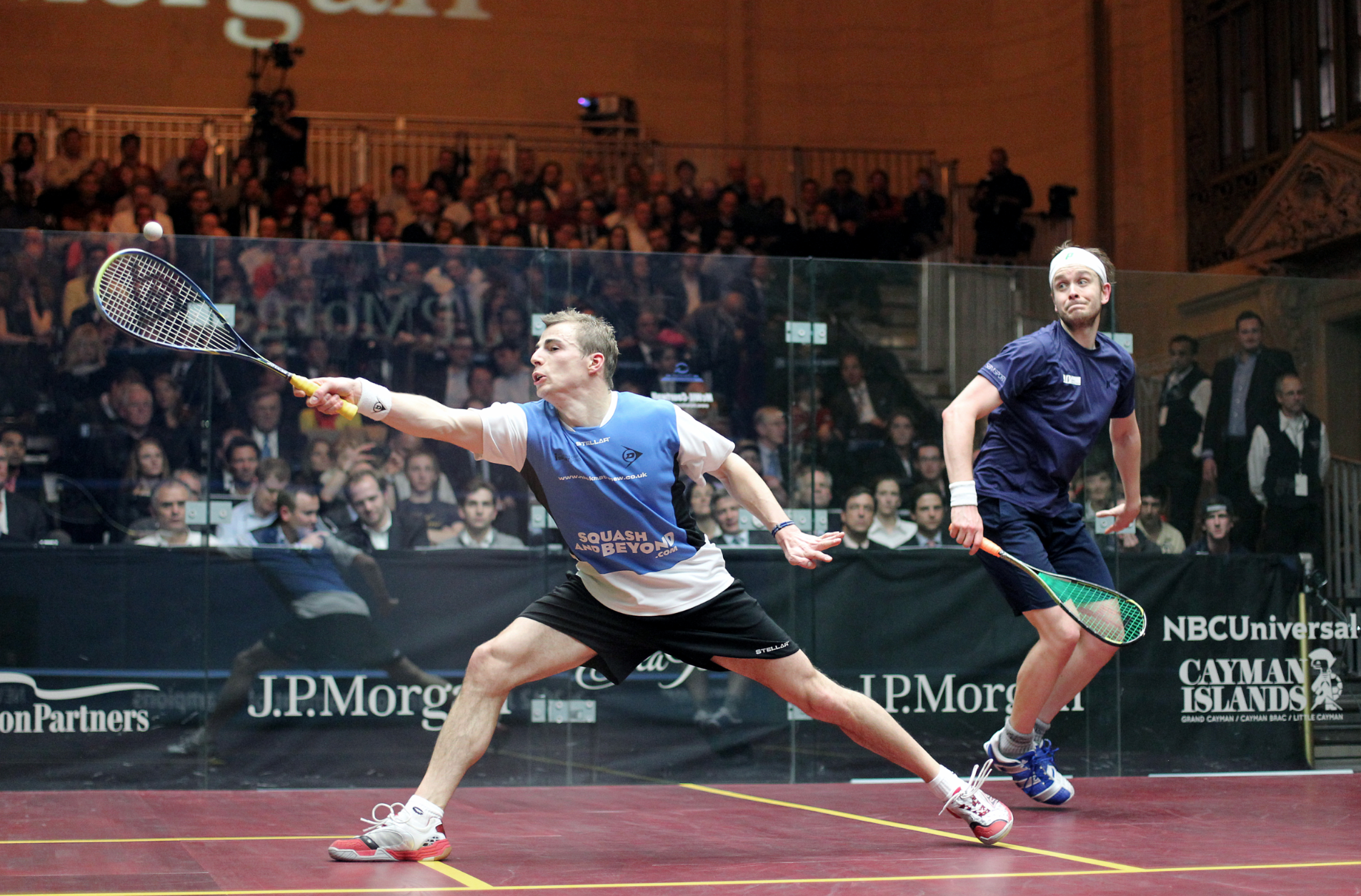
In person, the bleachers in Vanderbilt Hall were stuffed with people, ordinary and not-so-ordinary: the premier of the Cayman Islands, McKeeva Bush, came to the finals—perhaps the first sitting head of state to attend the ToC. There was a forty- five minute gap between the end of the women’s finals and the start of the men’s and fifteen minutes before the men came out, almost every seat was filled and it was eight-deep on the front wall.
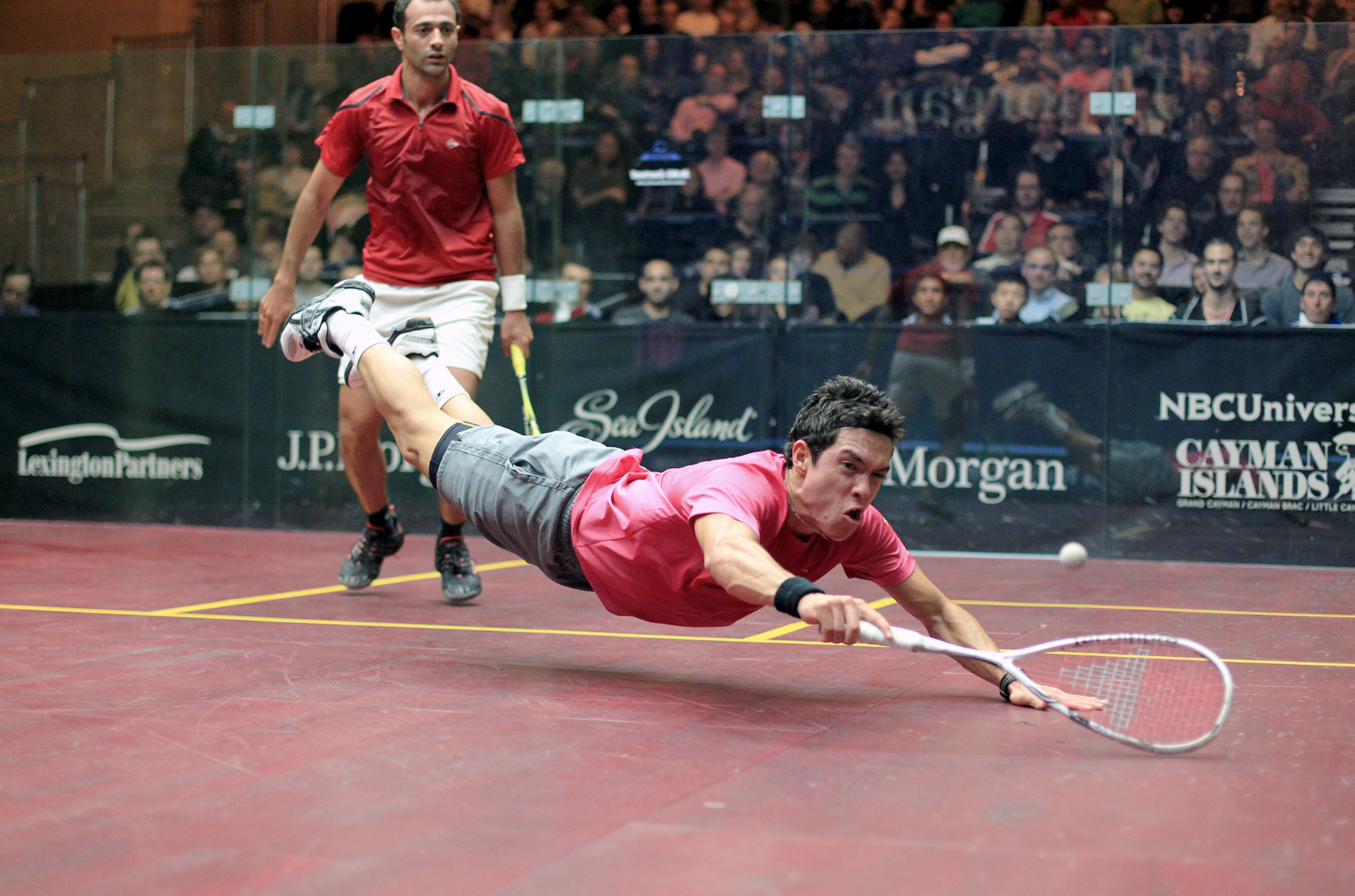
From the start of the qualies onwards, the men’s draw was the most exciting in years. Americans did well. Todd Harrity, the reigning national intercollegiate champion, took a surprising scalp in the first round of the qualies when he beat Mexico’s Cesar Salazar 12-10 in the fourth. Three other Americans lost in three games in the first round of the qualies, although Chris Gordon stayed on court for nearly an hour against Malaysia’s Ong Beng Hee. In the main draw, Julian Illingworth lost in four to longtime rival Shahier Razik of Canada.
Other qualifiers, though, made a huge impact in the main draw. Alan Clyne, a dour Scot, outlasted France’s Martin Castagnet in a two-hour 12-10 in the fifth match in the qualies, caught the midnight train out to his billet in Greenwich and still had enough horsepower to push England’s Adrian Grant to four in the main draw. (Two other matches in the qualies went to five long games—the level there is higher than ever.) The two El Shorbagy brothers reached the quarters. Marwan, the 18-year-old current world junior champion, survived a five-gamer with Adrian Waller in the qualies and then dispatched Thierry Lincou in the opening round—the next day Lincou told me that he was mentally tired and might retire before the 2013 ToC. Everyone was talking about Miguel Angel Rodriquez, the pint-sized Colombian acrobat who qualified, then beat Hisham Ashour 11-9 in the fifth before pushing Amr Shabana to five in the second round. Daryl Selby went on a career-best run all the way to the semis before horrendous blisters on his feet slowed him down.
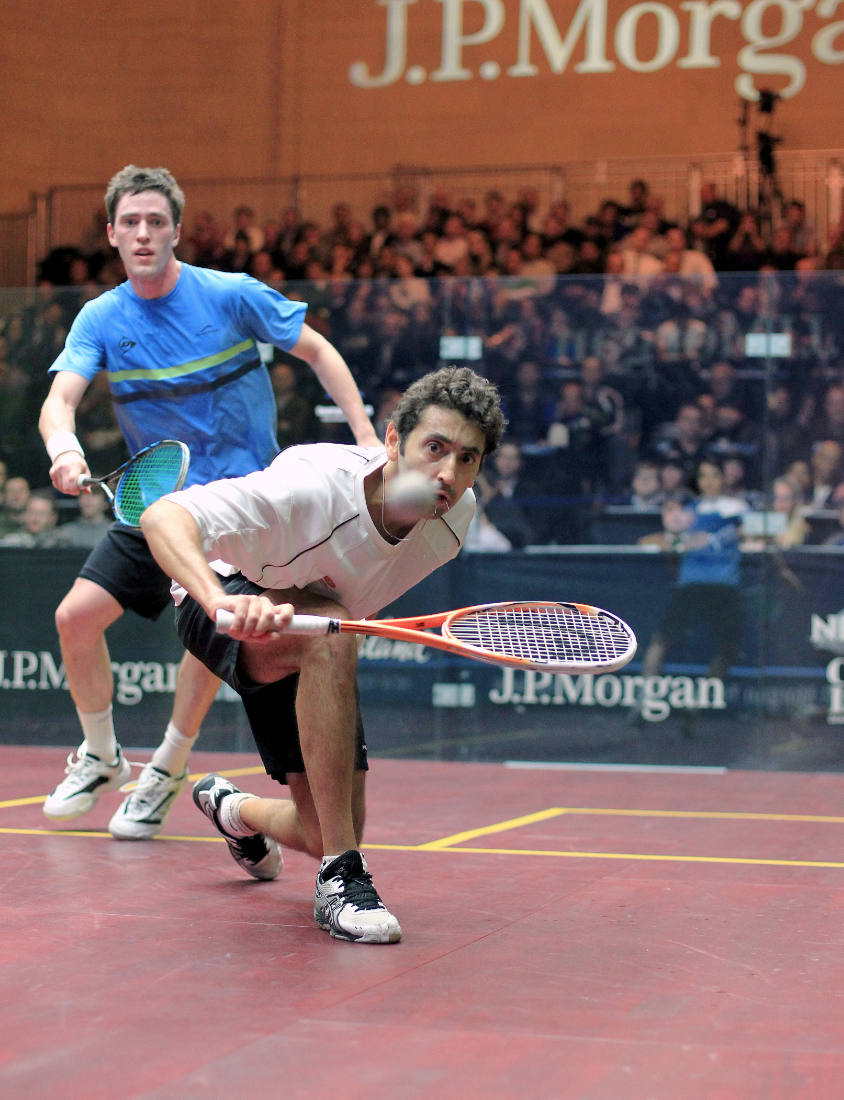
If that wasn’t enough magic, the Lexington Partners Legends Showdown that kicked off the ToC brought back the two men most synonymous with squash in Grand Central: Jonathon Power and Peter Nicol. Along with Chris Walker and John White, the nostalgia voltage supplied by Power and Nicol made for a memorable evening.
From the old to the new. For many years, the ToC had either no women’s draw at all or a non-ranking exhibition-style tournament, but this year Nimick was able to repeat what he had in 2002 and 2003 and stage a fully-fledged WSA event.
In the qualies, Americans made little headway, and in the main draw Olivia Blatchford went down quickly to Dipika Pallikal. But Latasha Khan shocked New York by pulling off one of the best wins in her career. The 39-year-old beat a woman half her age in the 18-year-old and higher-ranked Egyptian Nour El Tayeb.
Another match of experience versus youth came in the finals of the women’s ToC. Thirty-three year-old Natalie Grinham had a baby boy 19 months ago and is now on the comeback trail. In her first overseas outing with her son in tow, Grinham lost in the quarters in Greenwich but managed to come through to reach the finals at the ToC. She faced 20-year-old Indian star Pallikal who after beating Blatchford, toppled fourth seed Donna Urquhart and fifth seed Jaclyn Hawkes. In the finals, Pallikal had clearly lost steam—she had played nine matches in ten days and didn’t have the physical or mental energy to push against a motivated Grinham.
It was a fitting finale to an incredible week of squash in Grand Central. And nothing was better than having Tom and Hazel Jones on hand for many of the matches. They were in town for their induction into the U.S. Squash Hall of Fame. They did the pioneer work in putting on portable glass-court tournaments in New York a quarter century ago, back when the idea of having hundreds of thousands of people see a squash match was a pipe dream. They started making it a reality and it is even bigger and better than they imagined.

